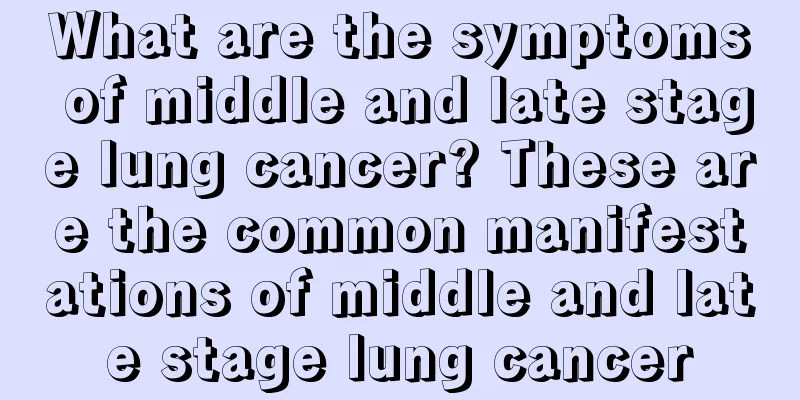What are the symptoms of middle and late stage lung cancer? These are the common manifestations of middle and late stage lung cancer

|
What are the symptoms of mid- to late-stage lung cancer? Once lung cancer is diagnosed, it is often in the mid- to late-stage. Some patients may not have obvious symptoms when they are first diagnosed, but as the disease progresses, the discomfort of the body will gradually increase. So what are the symptoms of mid- to late-stage lung cancer? In general, the symptoms of mid- and late-stage lung cancer vary depending on the patient's physical condition. Lung cancer is more serious in the late stage and requires timely symptomatic treatment. Common symptoms of mid- and late-stage lung cancer are: Chest pain: The chest cavity is a very complex space. Three-quarters of the lung surface is surrounded by the chest wall, which is composed of a thin layer of lining (parietal pleura), fat, muscle, ribs and skin in different proportions. Tumor invasion of any of the above parts will cause pain. Therefore, most patients with lung cancer that have regionally spread to the chest have symptoms of chest pain. Hoarseness: It is the most common symptom of patients with advanced lung cancer. The recurrent laryngeal nerve that controls the left side of the voice function goes down from the neck to the chest, bypasses the large blood vessels of the heart and goes back up to the larynx, thus controlling the left side of the voice organ. Therefore, if the tumor invades the left side of the mediastinum and compresses the recurrent laryngeal nerve, hoarseness will occur, but there will be no sore throat or other symptoms of upper respiratory tract infection. Shortness of breath, pleural effusion: Almost all patients with advanced lung cancer that has spread regionally have shortness of breath to varying degrees. Normal tissue fluid produced by the lungs and myocardium is returned by the lymph nodes in the middle of the chest. If these lymph nodes are blocked by tumors, this tissue fluid will accumulate in the pericardium to form pericardial effusion or accumulate in the chest cavity to form pleural effusion. Both of the above situations can cause shortness of breath. Facial and neck edema. On the right side of the mediastinum is the superior vena cava, which transports venous blood from the upper limbs and head and neck back to the heart. If the tumor invades the right side of the mediastinum and compresses the superior vena cava, it will initially cause the jugular vein to become swollen due to poor blood return, and eventually lead to facial and neck edema, which needs to be diagnosed and treated in a timely manner. The appearance of symptoms of mid- to late-stage lung cancer will seriously affect the quality of life of lung cancer patients, especially those in the late stage. The physical pain and psychological torture will weaken people's willpower and make them lose confidence in defeating the disease. Relieving the symptoms of mid- to late-stage lung cancer as soon as possible can not only improve the physical condition of patients, but also enable patients to build confidence in defeating the disease and actively cooperate with treatment, thus producing good treatment effects. |
>>: What are the causes of lung cancer? Five factors are likely to cause lung cancer
Recommend
What are the benefits of mulberry leaf foot bath
Many people are not aware of the acupuncture poin...
How effective is biological immunotherapy in treating colorectal cancer
Colorectal cancer is a disease that endangers peo...
What causes brain cancer? Can young people get brain cancer?
Brain cancer is a malignant tumor among brain tum...
What is radical resection of liver cancer
The main treatments for liver cancer include surg...
Can ozone remove formaldehyde?
Decoration pollution in modern life has become an...
Are crabs from rivers generally edible?
Many naughty children like to catch crabs in the ...
Methods to prevent cough with wheezing
I believe everyone has heard a sound, that is, so...
How to remove formaldehyde? Effective methods to remove formaldehyde
Formaldehyde is a chemical product that poses a g...
Can the bulging veins on the forehead be restored?
Protruding forehead veins are a problem that many...
The earlier the symptoms of bladder cancer are detected, the more help treatment can be provided
The incidence of bladder cancer in our country is...
Can you eat overnight spinach? Overnight vegetables have many harmful effects
Overnight vegetables are very harmful to our body...
What are the key points to pay attention to when caring for patients with laryngeal cancer
The incidence of laryngeal cancer is mainly relat...
Will I definitely get cervical cancer if I get infected with HPV? What are the ways to prevent cervical cancer?
It is currently believed that most cervical cance...
What is the method of giving oxygen by mask
Perhaps people don't have much knowledge and ...
Cure rate of mid- to late-stage testicular cancer
Testicular cancer is a malignant tumor that occur...









